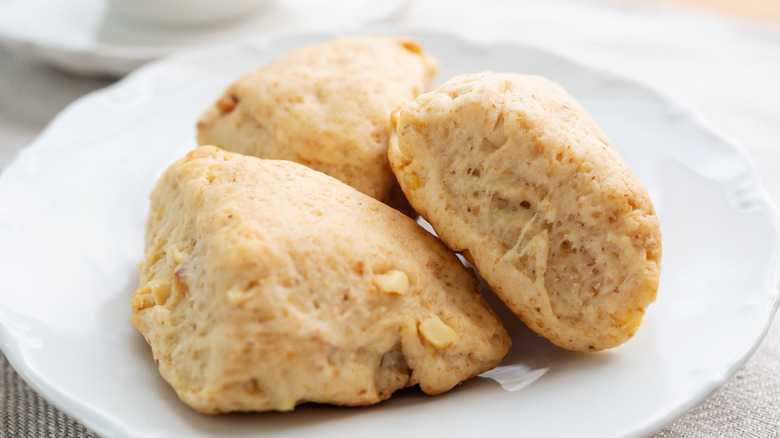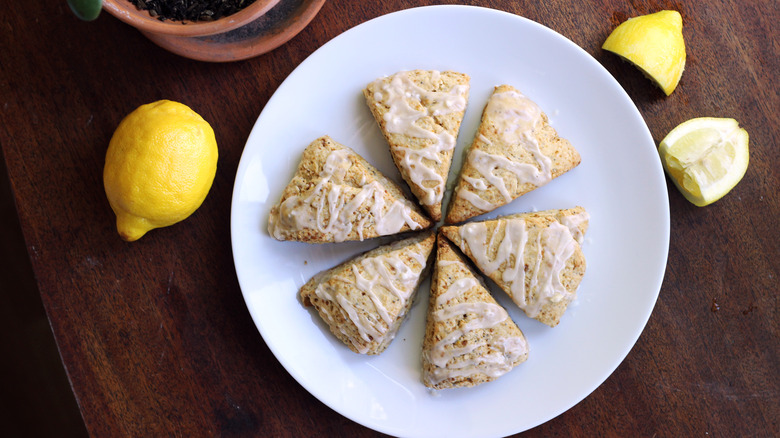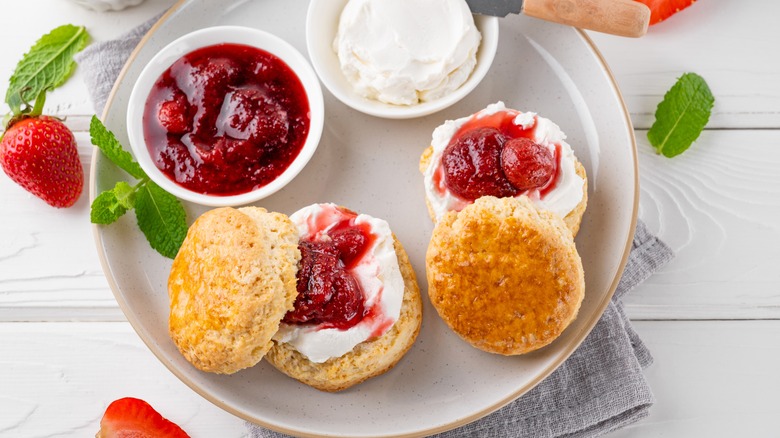British Vs. American Scones: Is There A Difference?
Depending on where people grew up or who cooked for them when they were young, scones might bring different flavors, textures, and smells to mind. Freshways explains that the origin of the scone dates back to 1513, thanks to the work of a Scottish poet marking a record of the food for the first time. The original scone popped up somewhere in Scotland, Ireland, Wales, or England and spread through word of mouth since most people at the time were illiterate. These baked goods were not made with the refined wheat flour we're so fond of today but instead baked oats, which were made into a wheel and wedged into the classic triangle shape many of us are still familiar with.
According to The Nibble, scones might have received their name from several sources. It is supposed that the term "scone" was pulled from the phrase "Stone of Destiny," which historically Scottish rulers perched upon. Another root word could have been the Gaelic word "sgonn," which loosely translates to "large mouthful" or something similar. These days, scones are baked in an oven instead of an open fire, vary in sweetness, and are served at different times and ways depending on what country you're eating them in. Scones are not made the same everywhere, and their global variety is best exemplified by comparing British and American versions.
American scones
In much of the United States, from the cold beaches of the Alaskan coastline to the warm palm-filled streets of Florida, if you sidle up to a bakery with its lights blinking awake in the morning light and ask for a cup of joe and a warm scone, you'll end up leaving with a brown paper bag full of a triangular wedge of sugary-pastry. Scones here in the U.S. are typically sweet and buttery, made with copious amounts of fat, heavy cream, and egg to create a dense yet surprisingly crumbly crumb structure that falls apart at the softest bite and melts in your mouth, via Simply Recipes.
Scones, while usually appropriate at any occasion or time of day in America, can be flavored with various ingredients, including blueberries, cranberries, poppy seeds, pumpkin, and lemon or orange, and are typically viewed as a sweet morning snack akin to a muffin. According to Sally's Baking Addiction, they are made not to be dressed in honey, jam, or butter like English scones but are meant to stand on their own though sometimes the addition of vanilla icing is encouraged. Bakers are careful not to over-knead them and ruin the texture of the baked goods; the ingredients are mixed and leavened with baking powder to make them pop up in the oven. Classic American scones are meant to have an inherently messy crumble and a rich sweet flavor that makes you regret only picking one piece to go.
British scones
If you grew up in the United States, odds are if you were asked if you wanted a scone, your first gut reaction would be to ask what flavor the pastry was, which is a valid question when it comes to American recipes. However, if you were to ask someone from the British Isles what flavor of scone they were offering, you'd receive a funny look. That's because, though they go by the same name, scones made across the pond are very different. Curious Cuisiniere says that the basic ingredients of a British scone are flour, a leavening agent, salt, fat, milk, a little sugar, and butter that is not fully incorporated into the dry ingredients before baking. British scones are traditionally drier, lighter, plain in flavor, and significantly less sugary than American scones and are commonly served for breakfast or with afternoon tea as a bready snack.
America's Test Kitchen claims that butter is one of the major differences between English and American scones. Fat adds that beautiful element of rich flavor and a soft-inner crumb to a scone, but while Americans will fold all that dairy into their recipe before popping it in the oven, the British tend to prefer cutting open their scones to slather butter or other condiments like jam in between the slices. The lower fat content in British scones makes the whole baked good taste lighter and might seem, to an American audience, more akin (at least visually) to a Southern biscuit.


